A meteor shower can produce the same awe-inspiring power as a quality acoustic guitar. Each note is like a glowing streak across an inky, moonless sky. Would you believe me if I told you that you don’t need to blast your budget to own an instrument that can catalyze such intimate, celestial magic? Here’s a hook, my bold claim: You CAN find premium resonance and sturdiness in an acoustic guitar under 1000 dollars. Intrigued?
From my own personal odyssey as a guitarist, beginning in my early youth, I’ve strummed numerous strings and heard countless melodic voices — each guitar unique, singing its signature song. My first adventure into serious instrument territory was right within this price range, turning the search for harmony between affordability and premium quality into an enduring passion. In this acoustic guitar buying guide, I want to explore that allure and excitement of hitting the sweet spot of quality and cost, finding an instrument that not only reverberates with the soulful heartbeat of a true guitarist but also conserves your hard-earned cash.
The journey to discover the best acoustic guitar under $1000 is navigated through understanding terms like ‘tonewood,’ assessing playability and comfort, and balancing budget with quality. Brace yourself to be plunged into detailed discussions about top-grade, mid-priced guitars like the Taylor 314ce and Martin DX1AE. You might just end this voyage cradling your perfect strum, an instrument that gives voice to your musical expression without cracking open the piggy bank.
Top-Rated Acoustic Guitars Under $1000
| Feature | Taylor 314ce | Martin DX1AE | Seagull S6 Original | Yamaha A-Series A3M |
|---|---|---|---|---|
| Body Shape | Grand Auditorium | Dreadnought | Concert Hall | Dreadnought Cutaway |
| Top Wood | Sitka Spruce | Sitka Spruce | Cedar | Sitka Spruce |
| Back & Sides Wood | Sapele | High Pressure Laminate | Wild Cherry | Mahogany |
| Neck Wood | Mahogany | Rust Birch Laminate | Maple | Mahogany |
| Fretboard Material | Ebony | Richlite | Rosewood | Ebony |
| Electronics | Expression System 2 | Fishman Sonitone | Optional | SRT2 System |
| Scale Length | 25.5 inches | 25.4 inches | 25.5 inches | 25.6 inches |
| Price Range | Upper range | Mid range | Entry level | Mid range |
Taylor 314ce
Best for Live Performances
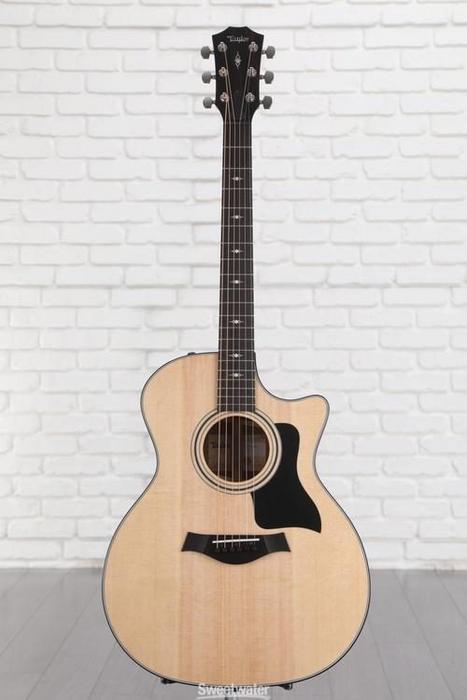
As a fingerstyle guitarist, my Taylor 314ce has been an invaluable asset to my performances. Unlike many other models, this guitar, one of the finest Taylor guitars under 1000, effortlessly blends playability and a robust tone. The highlight of this model is its spectacular premium tonewood design, lending it unmatched resonance and lush tones.
One memorable experience that comes to mind is a live performance I participated in last summer. The applause that followed my rendition of a classic ballad still rings in my ears. Part of that applause was for the 314ce, which contributed significantly to the moving performance with its nuanced tone and reliable playability.
Compared to the Martin DX1AE, a strong contender in the ‘Top-Rated Acoustic Guitars Under $1000’ category, the 314ce has an edge with its unparalleled tonal balance and playability—a feature most fingerstyle guitarists will appreciate. While the Seagull S6 Original might win on affordability, the rich tonal clarity and projection of the 314ce are hard to match.
However, it’s not without its challenges. The Yamaha A-Series A3M, another commendable option, offers better versatility across different music styles. Even then, the Taylor 314ce holds its ground with its specialized features for live performances.
Pros:
- Premium tonewood construction enhances sound clarity and resonance.
- Superior playability and comfort for fingerstyle guitarists.
- Perfect for live performances with rich, nuanced tones.
Cons:
- May not suit all music styles.
- Costlier than some other top rated guitars under $1000.
In conclusion, the Taylor 314ce is a priceless addition to this ‘Best Acoustic Guitar Under $1000: Find Your Perfect Strum’ lineup. Its specific focus on fingerstyle playability and live performance capability make it a remarkable option. It’s worth every penny, and maybe even a slight stretch of your budget.
Martin DX1AE
Best for Traditional Martin Tone
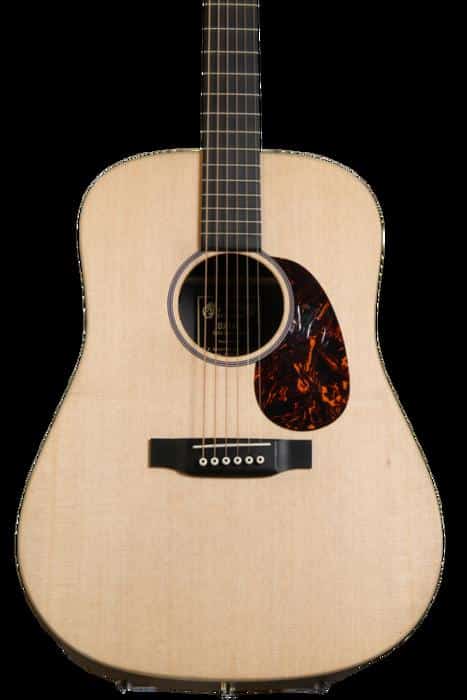
Transitioning from the vibrant tone of the Taylor 314ce, the Martin DX1AE manifests a classic blend of tradition and innovation amongst Martin guitars under 1000. As an avid player and admirer of solid wood acoustic guitars for years, I’ve developed an acute ear for the subtle tonal nuance that differentiates a dreadnought from a concert, and the DX1AE definitively reaffirms my affinity for the former.
The very core of Martin’s timeless sound that etched into my musical journey has been replicated masterfully in the DX1AE. Its rich tone is a perfect librarian for all my instrumental tales, bringing me back in time to the epoch of old-school blues and folk. When in use, the DX1AE feels like a trusted friend, capable of expressing anything from a mournful melody to an exciting, lively strum.
Comparatively, the Seagull S6 Original and Yamaha A-Series A3M, provides their unique harmonic character. Yet, they don’t quite capture the nostalgic allure that the DX1AE offers. The S6 glides towards a slightly brighter tonality, while the A3M’s focus on modern sound projection doesn’t quite encompass the depth the DX1AE manages to reach.
The DX1AE is a masterpiece of budget-friendly craftsmanship, truly setting the bar within the array of Martin guitars under 1000.
Pros:
- Distinct, warm and nostalgic tone compared to other brands.
- Excellent build quality promising durability.
Cons:
- Lacks the modern sound projection of similar price range models.
- May not be suitable for those seeking brighter tone.
In conclusion, despite the minor tradeoffs, the DX1AE’s authentic tonality and build quality sets it apart as a prime choice amongst top-rated acoustic guitars under $1000 for any traditional music enthusiasts like me.
Seagull S6 Original
Best for Beginners
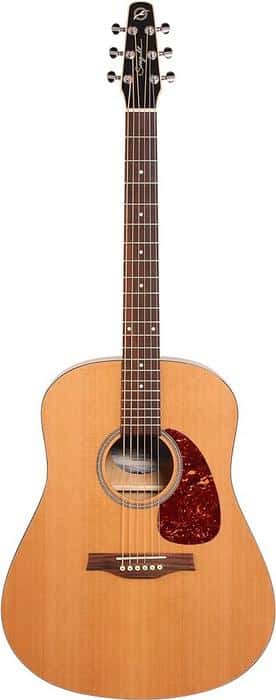
Having journeyed from my modest beginnings strumming chords to more sophisticated musical renditions, my appreciation for the Seagull S6 Original has never waned. I discovered that Seagull acoustic guitars are not just affordable acoustic guitars, but are truly instruments of value and quality.
In the realm of spruce top guitars under a grand, the Seagull S6 stands out. For beginners, it promises and delivers an engaging interaction, with an ease of play that makes the learning curve smoother. I’ve observed how my students’ eyes light up when their fingers coax the first clear notes from this instrument.
Compared with its competitors, like the Taylor 314ce and the Martin DX1AE, the Seagull S6 offers a delicate balance of affordability, playability, and sound clarity. While the Taylor 314ce excels in projection and Martin DX1AE is noted for its rich bass, the Seagull S6 finds a middle ground with its warm, balanced tone and responsiveness, making it approachable for novices.
With its solid cedar top and wild cherry back, this guitar presents a uniquely natural sound which my students appreciate as it helps them to cultivate their individual musical voices early on in their journey.
Pros:
- Exceptional playability for beginners.
- Articulate and balanced tone.
- Affordable in comparison to its quality.
Cons:
- May lack the depth of tone found in higher-end models.
- Requires regular maintenance to preserve its sound quality.
The Seagull S6 Original is indeed an invaluable stepping stone for any beginner guitarist, offering an unbeatable mix of affordability and quality that few guitars in this category match. It’s been a joy to discover and share this versatile instrument within my musical world, and I hope other novices will feel the same inspiration I did during my early years of exploring guitar music.
Yamaha A-Series A3M
Best for Versatile Sound
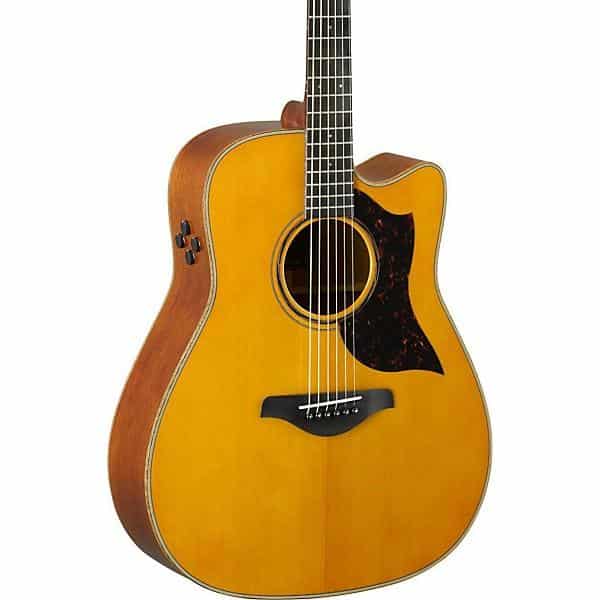
As a musician with a penchant for genre-blending, finding the perfect guitar has always been a matter of versatility for me. Therefore, my search led me to Yamaha acoustic guitars, and more specifically, the A-Series A3M, which offers an adaptable and versatile sound perfect for my musical exploits.
One memorable evening, I remember picking up the A3M and immersing myself in its beautiful resonance. The guitar’s versatility became evident as I traversed genres, from blues to pop, its sound shifting and shaping accordingly. With the A3M, my mid-priced acoustic guitar, I had found an instrument capable of matching my diverse musical palette flawlessly.
The Yamaha A3M stands proudly among top-rated acoustic guitars under $1000, showing that quality doesn’t necessarily compromise affordability. The well-crafted rosewood back and sides contribute to a warm and layered sound, while also offering sturdy durability. I consider it a reliable companion catering to my inventive journey of sound exploration.
Pros:
- Highly adaptable across various genres
- Durable rosewood construction
Cons:
- Lacks the brighter tone of spruce models
- The sound may be too rich for some preferences
When compared to its peers like the Martin DX1AE and Taylor 314ce, the A3M delivers a distinct richness and versatility that’s tough to rival. The Martin DX1AE, though renowned, lacks the diverse sound of the A3M. And while the Taylor 314ce does offer a bright and full sound, it struggles to match the adaptability of the A3M. Despite having its distinct niche, the Seagull S6 misses out on the A3M’s warmth, generated by its rosewood construction. All these elements culminate in the A3M becoming a stand-out player in the category of top-rated acoustic guitars under $1000.
So, considering its features and my personal experiences, I can confidently recommend the Yamaha A3M for any experimenting musician desiring a versatile, mid-priced acoustic guitar.
Considerations When Choosing Your Acoustic Guitar
Understanding Guitar Body Shapes
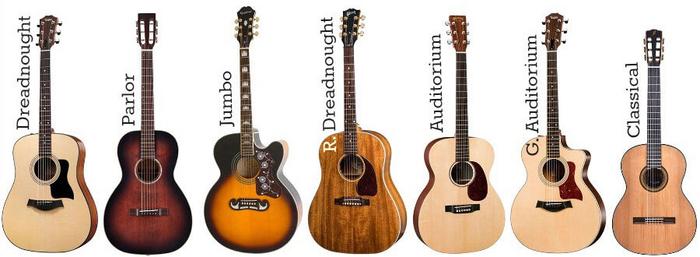
When perusing the myriad options for your perfect acoustic guitar, understanding body shapes is a crucial consideration. The familiar dreadnought vs concert guitars debate epitomizes this aspect. Just as a dance partner can lead, or be led, a guitar’s contour can steer your musical journey.
Dreadnought guitars, known for their robust, balanced sound, are ideal for vigorous strumming. Its full-sized body offers a loud, vibrant tone which is rich in bass frequencies. Yet, its broad waist might be cumbersome for some, affecting comfort during prolonged play.
On the other hand, a concert guitar’s smaller size and tighter waist facilitate precision and comfort, especially for fingerstyle players. It pronounces the midrange frequencies, offering a well-defined, focused sound that truly stands out in a mix.
It’s a dance of subtlety and nuance, where the variances in body shape contribute to the guitar’s voice and your playability. It affects your style, the music’s texture, and even the tale your tune tells. Whether you choose a dreadnought or concert guitar, remember, it becomes part of your musical choreography.
This shared dance is essential for creating the music you love. So, allow your understanding of guitar body shapes to guide your choice, ensuring it resonates not only with your music but with you, the player!
Selecting the Right Tonewood
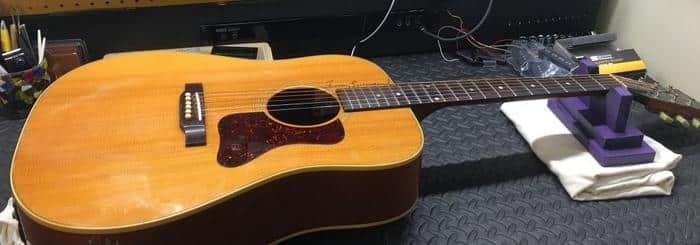
In my experience, the selection of the right tonewood is often underrated when considering acoustic guitar purchases, yet it is pivotal in both the playability and tone of the instrument. As I’ve found during my musical endeavors, premium tonewood guitars echo the depths of rosewood’s warmth, the crystalline highs of spruce, and the balanced tonal nuance of mahogany. Each one has its unique sonic imprint.
In choosing the right tonewood, I’ve learned to seek harmony between my musical style and the outcome I desire. If expressive warmth and complex overtones are what you’re after, rosewood won’t disappoint. Spruce, on the other hand, is renowned for its bright projection, making it excellent for live performances. Delving into my stories etched in grain, I can firmly say that understanding tonewood is a key stepping stone in your journey towards that perfect strum.
Only when handled and experienced can you understand the nuances and the personality of each tonewood. Embedding this insight will greatly enhance the selection process, marrying your musical desires and tonewood choice to produce that perfect acoustic melody under $1000.
Importance of Playability and Comfort
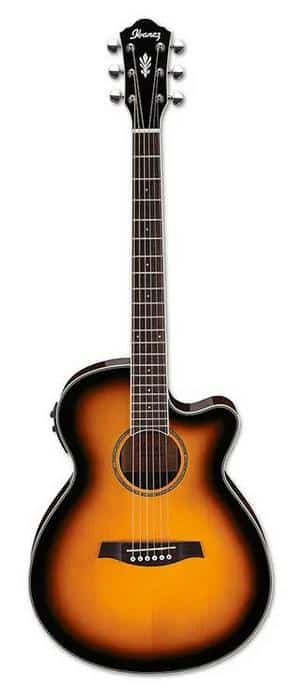
In your journey to find the perfect acoustic guitar to channel your talent, the relevance of guitar playability and tone cannot be overemphasized. As a seasoned guitarist myself, playability isn’t just a point to consider; it’s the very soul of the selection process.
Playing the guitar isn’t just about producing sound; it’s about the intricate sensory experience. The manner in which the strings sing under your fingertips, the feedback and connection you subtly feel from the neck of the guitar when it nestles comfortably in your palm, all these factors contribute to an intimate rapport between you and your instrument. The comfort of engaging with your guitar not only impacts your practice sessions but also enhances the assuredness of your performance.
Indeed, finding an instrument that feels ‘right’ in your hands and resonates favorably with your fingers is just as crucial as discovering your unique musical voice. Therefore, take your time to scrutinize the comfort and playability aspects of every promising guitar you come across. A carefully chosen guitar will not only serve as an extension of your artistry but also as a lifelong companion in your musical journey.
Balancing Budget and Quality

When it comes to the symphony of selecting the finest strum, the balance between budget and quality holds the center stage. The quest for affordable acoustic guitars often lands us amidst a cacophony of cheaply crafted options. But within this assortment, I have come across a symphony of harmony and craftsmanship that fuels the music within us.
Understanding that balance is crucial. Valuable inspiration can be found even within budget constraints, which may not necessarily resonate in pricier counterparts. Contrary to popular belief, the most expensive guitar doesn’t directly equate to the best guitar. A careful selection process can lead you to the best budget acoustic guitar that offers a rich auditory feast without loosening the purse strings too much.
My endeavors have always been driven by the search for such rare finds. A guitar that not only aligns with my budget but also encapsulates the fine nuances of craftsmanship – facilitating the mellifluous tunes that enamor the listener. Through my journey, I have realized that the perfect blend of affordability and quality is not a myth but a reachable reality if you know where to look and what to look for.
As we move on to discussing the ideal body shapes, tonewoods, and playability, remember this fundamental component. Balancing budget and quality is a tune that can make your journey of guitar selection a melodious experience.
FAQs
What characteristics define the best acoustic guitar under $1000?

When discussing the most influential characteristics that define the best acoustic guitar within a budget of $1000, we cannot overlook three fundamental attributes drawn from my extensive experience: durability, rich and resilient acoustics, and an intimate responsiveness to the musician’s touch. Endurance, or the guitar’s resistance to wear and exterior damage, ranks high in my list. A robust construction ensures the guitar’s longevity, making it an investment that truly pays off.
Next, tonal richness is crucial. The depth and balance of sound can truly elevate a performance, hitting the sweet spot between bass and treble. Opt for guitars with a hearty resonance, seamless clarity, and a naturally full-bodied sound. Lastly, the instrument’s response to your touch, or sensitivity, completes this trifecta. The best guitar is an extension of the player, responding intuitively to your strumming or picking. It should reinstate your intent in music, mirroring your emotional landscapes.
In the subsequent section, we’ll delve deeper into how these distinguishing traits play out in varied models within the $1000 ambit, namely the Taylor 314ce, Martin DX1AE, Seagull S6 Original, and Yamaha A-Series A3M. These handpicked guitars each embody a unique melange of the stated qualities, ensuring their status as top contenders in this price range.
How do I maintain the quality of a mid-priced acoustic guitar?

Maintaining the quality of your mid-priced acoustic guitar is an essential, and highly rewarding, part of owning such an instrument. As we previously explored in the sections related to the Taylor 314ce, Martin DX1AE, Seagull S6 Original, and Yamaha A-Series A3M, each guitar’s unique voice brings its own captivating character to your music. By taking certain measures, you can ensure this voice remains vibrant for many years to come.
Dedicated care is the key ingredient. My guitars that have shared with me countless tours, studio sessions, and homespun jam sessions always receive diligent maintenance. It’s never a chore; it’s an act of honoring our shared musical journey. Simple actions—such as regular cleaning, string replacement, and properly storing your guitar away from direct sunlight and drastic temperature changes—can work miracles for longevity.
Next, frequent tune-up check-ups, invaluable whether you’re going to be playing a Yamaha A-Series A3M at local pubs or a Taylor 314ce in packed concert halls. Having it checked professionally ensures your guitar’s sound stays in its prime. I’ve found these steps indispensable in maintaining both the quality and the musical integrity of my instruments. By incorporating the same methods, your chosen mid-priced acoustic guitar should continue to strum beautifully, adding even more value to your initial investment.
Combined with thoughtful considerations when initially choosing your guitar, attentive maintenance can elevate a mid-range instrument to new heights.
Conclusion
As we sign off from our melodic expedition, could the next guitar you hold be the one that turns every tune into an anthem of your soul? With the assistance of our concise acoustic guitar buying guide, you’ve traversed the varied terrain of quality acoustic guitars under $1000. We’ve explored the unvarnished charm of the Taylor 314ce, the rich tones of the Martin DX1AE, the robust resonance of the Seagull S6 Original, and the balanced blend of the Yamaha A-Series A3M.”
Our lyrical journey through forests of strings and frets concludes, and I encourage you on yours. The quest for an acoustic guitar isn’t just about economic prudence; it’s about finding an instrument that resonates with your musical soul. Your guitar should be an extension of your ambitions, a faithful companion that echoes your emotions, withstands life’s rhythm, and helps you reach new melodic milestones.
Remember, acquiring a quality acoustic guitar is an investment in your passion. As you hold various guitars, may the intricate designs, the subtle variations in tone and comfort, speak to you. Using the wisdom from this guide, find that perfect strum and let your music take flight.